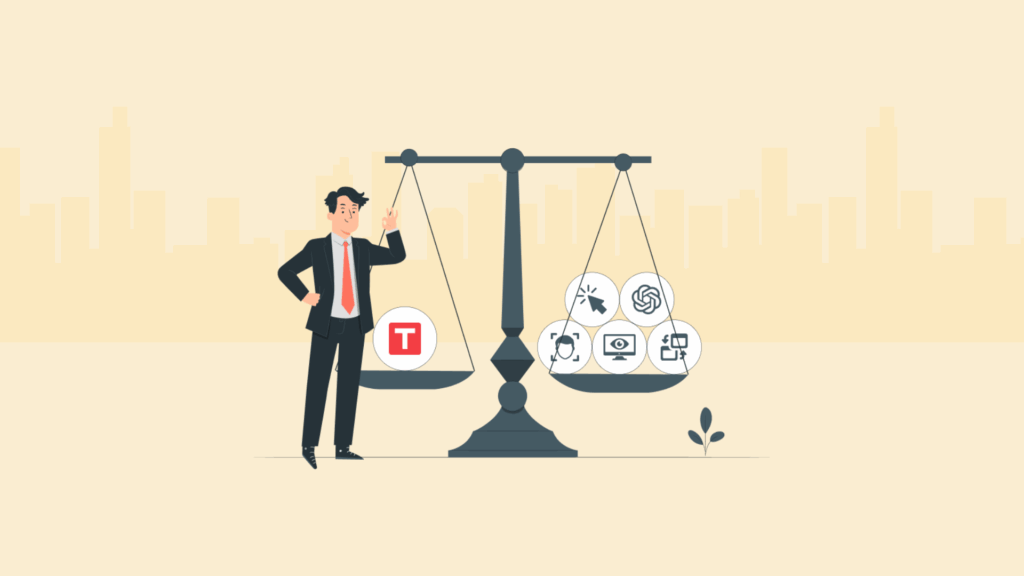Interviews are essential to hiring, providing insights into a candidate’s skills, personality, and cultural fit. But as a recruiter, have you ever wondered which interview format is better: structured or unstructured?
You may have often faced difficulty deciding whether to use a structured or unstructured approach. Both methods have their merits, but they also come with unique challenges. Knowing the right time and approach to use either can make a big difference in your hiring process.
But before diving into which is “better,” let’s first define each approach and understand how it functions.
Summarise this post with:
What is a structured interview?
A structured interview refers to interviewing candidates in a standardized manner. Under this technique, the candidates’ questions remain the same for all and in the same sequence; a standardized scoring system assesses their responses. Structured interviews are generally formal and rigid and leave little leeway for deviation.
Characteristics of structured interviews
- Pre-defined questions: All interviewers use a list of predetermined questions.
- Consistent evaluation criteria: Candidates are rated based on a pre-established scoring system.
- Objective approach: There’s minimal room for bias as each candidate is evaluated based on the same criteria.
How structured interviews work
Generally, it begins with identifying the important competencies, skills, and experience for the job, then proceeds with designing questions to assess those competencies. For example, if a critical skill for the job is problem-solving, some scenario-based questions might be included to assess how a candidate addresses and solves problems.
During the interview, the interviewer takes down each candidate’s response and scores as per the guide followed. Such an approach gives every candidate an equal chance of expressing himself, and the decision is more data-driven.

What is an unstructured interview?
An unstructured interview can be flexible and free-flowing, rather than consisting of a set list of questions, and an interviewer can lead the conversation in whatever way they feel is required. Such interviews are also often used to understand a candidate’s personality, cultural fit, and interpersonal skills.
Characteristics of unstructured interviews
- Flexible format: Interviewers may ask different questions to different candidates.
- Open-ended questions: The conversation flows based on the interviewer’s instincts and the candidate’s responses.
- Subjective approach: Since no standardized evaluation criteria exist, the decision may rely more on the interviewer’s impressions.
How unstructured interviews work
In an unstructured interview, the interviewer usually starts with a few general questions but allows the conversation to develop organically. They may probe deeper into a candidate’s responses or veer off into unrelated topics to explore their personality, work style, or unique experiences.
Unstructured interviews can feel more like a conversation than a formal assessment, which can put candidates at ease. However, they also introduce the risk of inconsistency and bias, as different candidates may be asked entirely different questions.
Key differences between structured and unstructured interviews
Understanding the differences between structured and unstructured interviews is crucial for choosing the right approach. Let’s break it down:
Structured vs unstructured interview
| Structured Interview | Unstructured Interview |
| Pre-determined and standardized questions | Flexible and open-ended questions |
| High consistency across all candidates | Low consistency; each interview can be different |
| Scored based on a fixed scoring system | Largely subjective, based on the interviewer’s perception |
| Less prone to interviewer bias | More prone to bias, as decisions are less structured |
| More time-efficient due to structured nature | It can be time-consuming, as conversations vary in length |
| Focuses on specific job-related competencies | It may provide deeper insight into personality and cultural fit |
Advantages of structured interviews
Structured interviews have many advantages that make them perfect for specific hiring conditions.
1. Fairness and objectivity
Structured interviews can prove very fair, as all the candidates answer identical questions, and the judgments are based on the same parameters. This is more applicable to jobs requiring technical skills or competencies of a specific nature.
2. Consistency
Since the same questions are asked in the same order, structured interviewing offers a system through which candidate comparison becomes easy and objective.
3. Legal defensibility
Structured interviewing has a hand in legal defensibility by the probability of not being considered discriminatory since it depends on pre-determined questions and objectivity.
4. Saves time for bulk hiring
And when hiring for several positions, the cut-off time is assured in this streamlined and efficient process.
Disadvantages of structured interviews
1. Limited flexibility
Structured interviews don’t leave much scope for spontaneous follow-up questions or going off the script. This may prevent interviewers from looking deeper into a candidate’s personality and what makes him special.
2. Can feel impersonal
Because of the strict format, structured interviews can seem mechanical sometimes, hence less natural between the interviewer and the candidate.
3. Less focus on soft skills
While structured interviews are very effective in checking technical competencies, they are not very effective at measuring soft skills such as emotional intelligence or creativity, where storytelling often happens with open-ended conversations.
Advantages of unstructured interviews
Unstructured interviews carry their share of benefits that may help the hiring process.
1. Deeper insights into personality
Since an unstructured interview is a conversational and wide-open interview, this type of interview often gives the interviewer opportunities to understand a candidate’s personality, motivation, and fit with the organization’s culture. This can be very useful when soft skills are required.
2. Flexibility to explore
In an unstructured interview, there is room for flexibility to “go deeper into topics or other areas of interest that come up in the conversation”; thus, this will provide the interview with much scope for organic and nuanced interaction.
3. Builds rapport
Unstructured interviews can make the interviewer informal; this would help develop rapport with the candidate, which makes the candidate feel comfortable, thus allowing a real exchange.
Disadvantages of unstructured interviews
1. Inconsistent evaluations
The lack of any standard questions and assessment criteria makes unstructured interviews leave room for unequal assessments of candidates. Candidates cannot be compared on a level playing field.
2. Possibility of bias
Since unstructured interviews rely a lot on the instincts of the interviewer and their perception, they easily carry biases. The interviewer may have a subconscious bias toward candidates with whom they resonate personally, irrespective of whether the candidate would be suitable for the job.
3. Time-consuming
Unstructured interviews often take a long time and are unpredictable. Interviewers may also discuss issues irrelevant to checking the candidate’s job-related competencies.
When to use structured interviews?
Structured interviews are best used when:
- Hiring for roles requiring specific technical skills or competencies.
- Ensuring fairness in the hiring process is critical, such as in large organizations or government roles.
- You need to quickly evaluate many candidates for the same role, such as in mass recruiting.
- Legal defensibility is a concern, and you want to minimize the risk of discrimination claims.
When to use unstructured interviews?
Unstructured interviews are ideal when:
- Hiring for roles where cultural fit and personality are more important than technical skills, such as creative or leadership positions.
- You want to explore a candidate’s unique experiences and how they relate to the role.
- Building rapport and putting the candidate at ease is important for a more genuine exchange.
Blending structured and unstructured approaches
For many recruiters, a hybrid approach may be the best solution. By blending elements of structured and unstructured interviews, you can enjoy the benefits of consistency and objectivity while allowing for flexibility and deeper exploration.

Example of a hybrid approach
Start with core structured questions focusing on key competencies or job-specific skills. Once you’ve covered the basics, transition into a more unstructured conversation where you can explore the candidate’s personality, work style, and cultural fit. This method provides a balance between fairness and depth.
Final thoughts
Both structured and unstructured interviews play a role in the recruitment process.
The best approach often depends on the nature of the role you are hiring for. For example, structured interviews work great if one wants uniformity to ensure fairness in front of everyone. Still, unstructured interviews allow one to go beyond the professional dimension to the personality and the potential cultural fit.
You will eventually select the approach – or approaches – that best align with the needs of the role and your organization. With it, you’ll be able to receive better quality hiring decisions and find the right talent for your team.
























